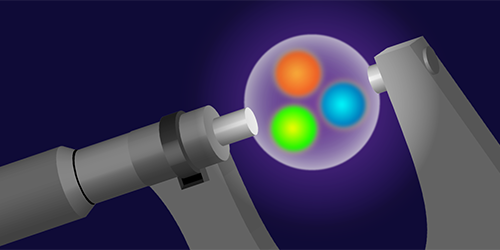Putting the Proton Radius in Its Proper Place
How big is the proton? That seems like a straightforward question, but a clear answer is hard to come up with. Several experiments have reported measurements of the proton radius, but their values differ by 4%. The puzzle is sometimes framed in terms of the proton’s three-dimensional charge density, but this is a misconception, says Gerald Miller from the University of Washington, Seattle. In a new study, Miller shows how the proton radius can be defined in a unified way according to photon-proton interactions.
The first measurements of the proton radius were based on the energy levels of hydrogen, giving a value of around 0.88 femtometers. A similar result was suggested by experiments scattering electrons off proton targets. However, in 2010, researchers measuring energy transitions in muonic hydrogen (an artificial atom with a muon replacing the electron) found a smaller proton radius of around 0.84 femtometers.
In trying to understand the origin of this discrepancy, researchers have often related the proton radius to the “outer edge” of a three-dimensional charge density. However, as Miller points out, the proton’s interior is not so simple. It contains relativistically moving quarks and gluons, whose spatial distribution (or wave function) depends on the proton’s momentum. Measuring the proton will disturb its momentum and generally alter its interior wave function. Ultimately, a three-dimensional charge density is undefinable.
Miller shows that all of the relevant experiments boil down to measuring the same thing: the slope of the proton’s electric form factor, which describes how big of a target the proton is for photon interactions. By presenting this unified treatment, Miller hopes to prevent any unnecessary confusion that might hinder progress in finding the solution to the proton radius puzzle.
This research is published in Physical Review C.
–Michael Schirber
Michael Schirber is a Corresponding Editor for Physics based in Lyon, France.





